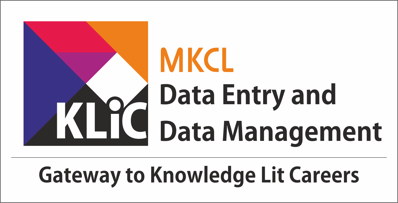- In this course, you will learn to:
- Define the key concepts of data management and its importance
- Identify the different stages of data management and their applications
- Illustrate the process of data analysis and its role in decision-making
- Set up and use Google Data Studio for data visualization
- Manage data efficiently using Google Drive and One Drive
- Create and modify forms and queries in MS Access
- Analyze and generate advanced queries and reports in MS Access
- Perform data entry and management using SQL from basic setup to operations
- Apply advanced SQL techniques such as filtering, joins, and data types
- Optimize SQL queries using aggregation, Common Table Expressions (CTEs), and transaction control
- Construct advanced database designs using views and indexing for better performance
- Ensure data security, integrity, and performance optimization in SQL databases

Data Security and Ethical Considerations
Explore key principles of data privacy, ethics, and protection. Learn best practices for responsible data handling and security.
Introduction
What you'll learn ?
- At the end of this course, learners will be able to:
- Interpret the stages of data management and their impact on business efficiency
- Compare various tools like Google Drive and One Drive for effective data storage and management
- Examine data analysis techniques and apply them using Google Data Studio
- Construct functional queries and forms in MS Access for efficient data retrieval
- Appraise the effectiveness of advanced SQL queries in filtering and joining datasets
- Develop optimized SQL databases using advanced indexing and database design principles
- Verify the security measures applied to SQL databases to maintain data integrity
- Illustrate the process of data visualization with Data Squirrel for better insights
- Manage large datasets effectively using SQL transaction control and CTEs
- Predict the outcomes of data optimization techniques in SQL
- Propose advanced methods for database design to improve performance and scalability
- Assess the role of TOMAT and Data Squirrel in enhancing data analysis capabilities
- Create comprehensive data reports using Google Data Studio and SQL for business decision-making
Syllabus
- What is Data Management and how it differs from Data Entry?
- Typical Data Management Jobs in the market
- Data Management vs Data Governance
- Define Data
- Where do we use data?
- What is data management?
- How does data management help businesses to achieve their goals?
- What are the various steps involved in data management?
- Importance of Human Factor in Data Management
- How to establish Data Management Culture
- Data Policy
- Data Ownership
- Data Stewardship
- Data Custodianship
- Data Documentation
- Data Quality
- Data Security
- Data Redundancy
- Data Compliance
- Data Auditing
- Benefits of becoming data driven
- Cultivate proper teams of team data leaders
- Involving people in each step of transition process
- Integrating data from all sources
- Adopt technology for success
- Set and monitor key performance indicators
- What is a database?
- What mediums do professionals use for storing data?
- How do professionals organize and store official data?
- What are some good practices for organizing and storing data?
- What is Metadata?
- What are the types of metadata?
- What is Big Data?
- Define Data Analytics
- What course of study can you persue to become an expert in Data Analytics?
- What is social media marketing?
- What exactly is data collection from social media?
- How would you collect data from Facebook?
- How can you collect data from Instagram?
- Data Collection Techniques
- Data Cleaning Techniques: Downloading, Saving, and Cleaning data
- Data Cleaning Techniques: Freezing and Cleaning data
- What are relational data management systems?
- What can you do with SQL Server?
- Databases, Tables and Other objects in SQL server RDBMS
- SQL vs T-SQL
- Google Data Studio - An Introduction
- Data Sources
- Data Blending
- Data Blending inside
- Google Data Studio-Creating Reports and Chart Types
- Report canvas interface
- Creating chart types- Table, Pivot table
- Bar Chart
- Line Chart
- Time series chart
- Scorecard Pie Maps charts
- Community visualization
- Embed URL in reports
- Creating Groups
- Page and report level
- Creating multi page report with navigation
- Using parameters to get user input
- Copying chart formatting
- Managing data segments
- Regular expressions
- Right chart for your report
- Tips to create effective reports"
- What is Canva?
- What are the features of Canva?
- How can you create a free account in Canva?
- How can you use Canva to make a checklist for data collection?
- Outcome
- Managing Data on the Cloud
- Introduction to Google Drive
- Getting Started with Google Drive
- Google Drive for Web, Mobile and PC
- Creating a New File
- Uploading and Syncing Files
- Managing your Files
- Searching files from Google drive
- Organizing the files in Google drive
- Sharing and Collaboration of Files
- Downloading and Printing Files
- Google Drive vs One Drive
- Introduction to One Drive
- Getting Started with One Drive
- One Drive for Web, Mobile and PC
- Creating a New File
- Uploading and Syncing Files
- Managing your Files
- Searching files from One Drive
- Organizing the files in One Drive
- Sharing and Collaboration of Files
- Downloading and Printing Files
- Introduction Video to Data Entry
- Understand Database Essentials for MySQL
- Get Started: MySQL for Beginners
- Install and Configure MySQL - A Step-by-Step Guide
- Grasp Relational Model Basics for Database Design
- Create and Structure Tables: Rows and Columns Mastery
- Introduction Video to Data Entry
- Execute SQL Commands: SELECT, INSERT, UPDATE, DELETE
- Filter and Sort SQL Queries for Enhanced Data Retrieval
- Simplify Queries: Mastering Aliases and Expressions in SQL
- Manage Data Types in SQL: A Comprehensive Approach
- Utilize Numeric, String, and Date Types in SQL Queries
- Craft Simple SQL Queries for Effective Data Analysis
- Introduction Video to Data Entry
- Query Across Multiple Tables: Mastering SQL Joins
- Apply INNER and OUTER JOINs: Advanced Table Relationships
- Aggregate Data: Using GROUP BY and HAVING in SQL
- Master GROUP BY and HAVING Clauses for Data Segmentation
- Introduction Video to Data Entry
- Advance Your Querying Techniques with SQL
- Utilize CTEs for Complex SQL Query Optimization
- Modify Data with SQL: INSERT, UPDATE, DELETE Mastery
- Manage Transactions in SQL for Data Integrity
- Create and Utilize SQL Views for Simplified Data Management
- Leverage Indexing for Enhanced SQL Query Performance
- Introduction Video to Data Entry
- Develop and Execute Stored Procedures in MySQL
- Implement User-defined Functions for Custom SQL Operations
- Apply Database Design Principles for Efficient Structures
- Master Normalization to Optimize Database Design
- Implementation of Primary Key and Foreign Key
- Introduction Video to Data Entry
- Enforce Data Integrity with Constraints in MySQL
- Manage Users and Permissions for MySQL Security
- Secure MySQL Database Access: Best Practices
- Plan and Execute MySQL Backup Strategies
- Achieve Point-in-Time Recovery for MySQL Databases
- Optimize SQL Queries for Maximum Performance
- Analyze SQL Query Execution Plans for Efficiency
- Introduction to Data Squirrel
- Installation and Setup
- Explaining the interface
- Understanding Data Sources and Connections
- Basic Data Manipulation Techniques
- Introduction to Data Visualization
- Advanced Data Manipulation
- Complex Data Visualization
- Data Analysis with Data Squirrel
- Automation and Scripting in Data Squirrel
- Case Study: Marketing Analytics
- Case Study: Financial Data Analysis
- Case Study: Operational Efficiency
- Best Practices in Data Squirrel
- Troubleshooting Common Issues
- Continuing Your Data Squirrel Journey
- What is TOMAT? An Overview
- Installing TOMAT and Setting Up the Environment
- The Contemporary Relevance of TOMAT
- Navigating the TOMAT Interface
- Basic Operations in TOMAT
- Advanced Data Analysis with TOMAT
- Use Cases and Case Study
- Best Practices and Tips for Efficient Use of TOMAT
- Q&A and How to Contribute to the TOMAT Community
Certificate
- MKCL provides certificate (for 30/60/90 hours courses) to the KLiC learner after his/her successful course completion.
Academic Approach
The Academic Approach of the course focuses on the “work centric” education i.e. begin with work (and not from a book !), derive knowledge from work and apply that knowledge to make the work more wholesome, useful and delightful. The ultimate objective is to empower the Learner to engage in socially useful and productive work. It aims at leading the learner to his/her rewarding career as well as development of the society.
Learning methodology
- Learners are given an overview of the course and its connection to life and work.
- Learners are then exposed to the specific tool(s) used in the course through the various real-life applications of the tool(s).
- Learners are then acquainted with the careers and the hierarchy of roles they can perform at workplaces after attaining increasing levels of mastery over the tool(s).
- Learners are then acquainted with the architecture of the tool or Tool Map so as to appreciate various parts of the tool, their functions and their inter-relations.
- Learners are then exposed to simple application development methodology by using the tool at the beginner’s level
- Learners then perform the differential skills related to the use of the tool to improve the given ready-made outputs.
- Learners are then engaged in appreciation of real-life case studies developed by the experts.
- Learners are then encouraged to proceed from appreciation to imitation of the experts.
- After imitation experience, they are required to improve the expert’s outputs so that they proceed from mere imitation to emulation.
- Finally, they develop the integral skills involving optimal methods and best practices to produce useful outputs right from scratch, publish them in their ePortfolio and thereby proceed from emulation to self-expression.
Evaluation Pattern
Evaluation Pattern of KLiC Courses consists of 4 Sections as per below table:
| Section No. | Section Name | Total Marks | Minimum Passing Marks |
|---|---|---|---|
| 1 | Learning Progression | 25 | 10 |
| 2 | Internal Assessment | 25 | 10 |
| 3 | Final Online Examination | 50 | 20 |
| Total | 100 | 40 | |
| 4 | SUPWs (Socially Useful and Productive Work in form of Assignments) | 5 Assignments | 2 Assignments to be Completed & Uploaded |
MKCL’s KLiC Certificate will be provided to the learner who will satisfy the below criteria:
- Learners who have successfully completed above mentioned 3 Sections i.e. Section 1, Section 2 and Section 3
- Additionally, learner should have completed Section 4 (i.e. Section 4 will comprise of SUPWs i.e. Socially Useful and Productive Work in form of Assignments)
- Learner has to complete and upload minimum 2 out of 5 Assignments
Courses Fee Structure from 01 July, 2025 Onwards
KLiC 30 hour course fee applicable from 01 July, 2025 all over Maharashtra| KLiC Course Duration | MFO: MKCL Share (Including 18% GST) |
ALC Share (Service Charges to be collected by ALC) |
|---|---|---|
| 30 hours | Rs. 300/- | Rs. 1,500/- |
Important Points:
* Above mentioned fee is applicable for all Modes of KLiC Courses offered at Authorised Learning Center (ALC) and at Satellite Center
* Total fee is including of Course fees, Examination fees and Certification fees
* MKCL reserves the right to modify the Fee anytime without any prior notice
* Above mentioned fee is applicable for all Modes of KLiC Courses offered at Authorised Learning Center (ALC) and at Satellite Center
* Total fee is including of Course fees, Examination fees and Certification fees
* MKCL reserves the right to modify the Fee anytime without any prior notice
